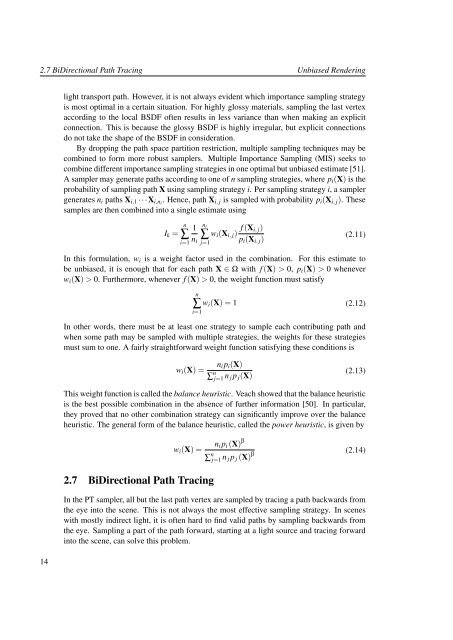Master Thesis - Computer Graphics and Visualization - TU Delft
Master Thesis - Computer Graphics and Visualization - TU Delft
Master Thesis - Computer Graphics and Visualization - TU Delft
Create successful ePaper yourself
Turn your PDF publications into a flip-book with our unique Google optimized e-Paper software.
2.7 BiDirectional Path Tracing Unbiased Rendering<br />
14<br />
light transport path. However, it is not always evident which importance sampling strategy<br />
is most optimal in a certain situation. For highly glossy materials, sampling the last vertex<br />
according to the local BSDF often results in less variance than when making an explicit<br />
connection. This is because the glossy BSDF is highly irregular, but explicit connections<br />
do not take the shape of the BSDF in consideration.<br />
By dropping the path space partition restriction, multiple sampling techniques may be<br />
combined to form more robust samplers. Multiple Importance Sampling (MIS) seeks to<br />
combine different importance sampling strategies in one optimal but unbiased estimate [51].<br />
A sampler may generate paths according to one of n sampling strategies, where pi(X) is the<br />
probability of sampling path X using sampling strategy i. Per sampling strategy i, a sampler<br />
generates ni paths Xi,1 ···Xi,ni . Hence, path Xi, j is sampled with probability pi(Xi, j). These<br />
samples are then combined into a single estimate using<br />
n 1<br />
Ik = ∑<br />
i=1<br />
ni<br />
ni<br />
∑ wi(Xi, j)<br />
j=1<br />
f (Xi, j)<br />
pi(Xi, j)<br />
(2.11)<br />
In this formulation, wi is a weight factor used in the combination. For this estimate to<br />
be unbiased, it is enough that for each path X ∈ Ω with f (X) > 0, pi(X) > 0 whenever<br />
wi(X) > 0. Furthermore, whenever f (X) > 0, the weight function must satisfy<br />
n<br />
∑<br />
i=1<br />
wi(X) = 1 (2.12)<br />
In other words, there must be at least one strategy to sample each contributing path <strong>and</strong><br />
when some path may be sampled with multiple strategies, the weights for these strategies<br />
must sum to one. A fairly straightforward weight function satisfying these conditions is<br />
wi(X) =<br />
nipi(X)<br />
∑ n j=1 n j p j(X)<br />
(2.13)<br />
This weight function is called the balance heuristic. Veach showed that the balance heuristic<br />
is the best possible combination in the absence of further information [50]. In particular,<br />
they proved that no other combination strategy can significantly improve over the balance<br />
heuristic. The general form of the balance heuristic, called the power heuristic, is given by<br />
wi(X) =<br />
2.7 BiDirectional Path Tracing<br />
nipi (X) β<br />
∑ n j=1 n j p j (X) β<br />
(2.14)<br />
In the PT sampler, all but the last path vertex are sampled by tracing a path backwards from<br />
the eye into the scene. This is not always the most effective sampling strategy. In scenes<br />
with mostly indirect light, it is often hard to find valid paths by sampling backwards from<br />
the eye. Sampling a part of the path forward, starting at a light source <strong>and</strong> tracing forward<br />
into the scene, can solve this problem.
















